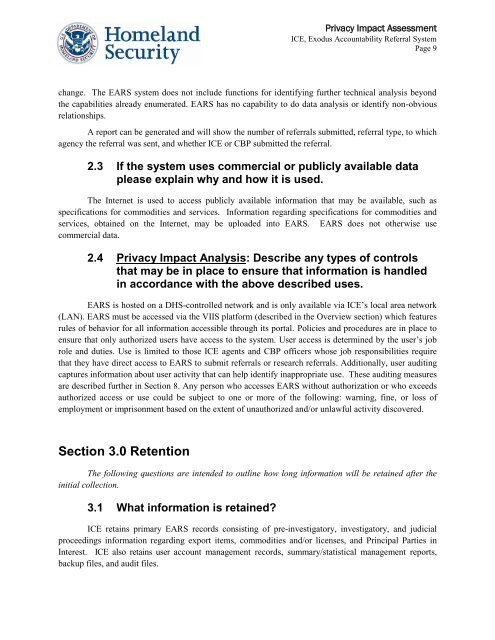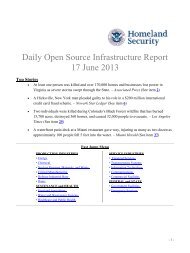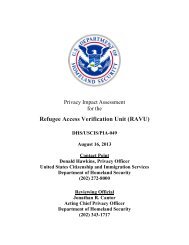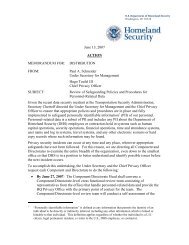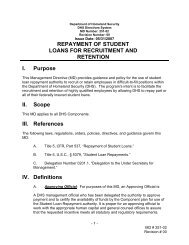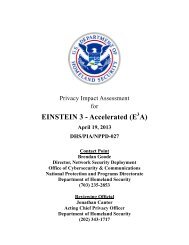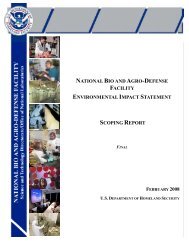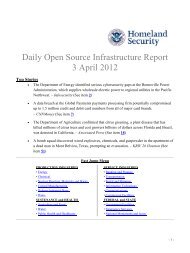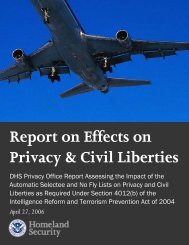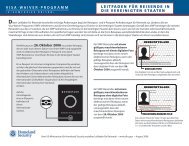Exodus Accountability Referral System (EARS) - Homeland Security
Exodus Accountability Referral System (EARS) - Homeland Security
Exodus Accountability Referral System (EARS) - Homeland Security
Create successful ePaper yourself
Turn your PDF publications into a flip-book with our unique Google optimized e-Paper software.
Privacy Impact Assessment<br />
ICE, <strong>Exodus</strong> <strong>Accountability</strong> <strong>Referral</strong> <strong>System</strong><br />
Page 9<br />
change. The <strong>EARS</strong> system does not include functions for identifying further technical analysis beyond<br />
the capabilities already enumerated. <strong>EARS</strong> has no capability to do data analysis or identify non-obvious<br />
relationships.<br />
A report can be generated and will show the number of referrals submitted, referral type, to which<br />
agency the referral was sent, and whether ICE or CBP submitted the referral.<br />
2.3 If the system uses commercial or publicly available data<br />
please explain why and how it is used.<br />
The Internet is used to access publicly available information that may be available, such as<br />
specifications for commodities and services. Information regarding specifications for commodities and<br />
services, obtained on the Internet, may be uploaded into <strong>EARS</strong>. <strong>EARS</strong> does not otherwise use<br />
commercial data.<br />
2.4 Privacy Impact Analysis: Describe any types of controls<br />
that may be in place to ensure that information is handled<br />
in accordance with the above described uses.<br />
<strong>EARS</strong> is hosted on a DHS-controlled network and is only available via ICE’s local area network<br />
(LAN). <strong>EARS</strong> must be accessed via the VIIS platform (described in the Overview section) which features<br />
rules of behavior for all information accessible through its portal. Policies and procedures are in place to<br />
ensure that only authorized users have access to the system. User access is determined by the user’s job<br />
role and duties. Use is limited to those ICE agents and CBP officers whose job responsibilities require<br />
that they have direct access to <strong>EARS</strong> to submit referrals or research referrals. Additionally, user auditing<br />
captures information about user activity that can help identify inappropriate use. These auditing measures<br />
are described further in Section 8. Any person who accesses <strong>EARS</strong> without authorization or who exceeds<br />
authorized access or use could be subject to one or more of the following: warning, fine, or loss of<br />
employment or imprisonment based on the extent of unauthorized and/or unlawful activity discovered.<br />
Section 3.0 Retention<br />
The following questions are intended to outline how long information will be retained after the<br />
initial collection.<br />
3.1 What information is retained?<br />
ICE retains primary <strong>EARS</strong> records consisting of pre-investigatory, investigatory, and judicial<br />
proceedings information regarding export items, commodities and/or licenses, and Principal Parties in<br />
Interest. ICE also retains user account management records, summary/statistical management reports,<br />
backup files, and audit files.


